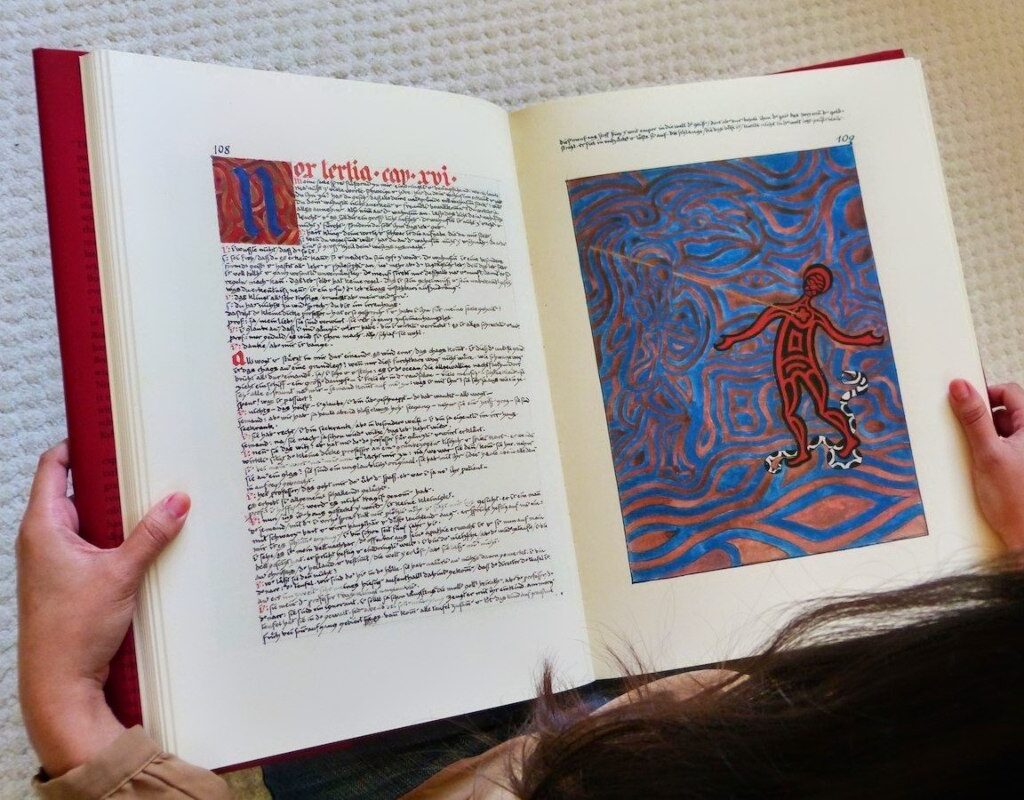Within the hidden chambers of a New York museum, a treasure awaited discovery by the world: The Red Book by Carl Jung. This monumental manuscript, delving into the depths of the unconscious mind of the renowned Swiss psychoanalyst, has been meticulously preserved and concealed for decades. Yet, this enigma, shrouded in mystery and complex calligraphy, will soon be unveiled.
The Mysterious Red Book of Carl Gustav Jung
A Hidden Gem Displayed at the Rubin Museum of Art
“Carl Jung and His Confrontation with the Unconscious: The Revelation of the Red Book”
Carl Gustav Jung, the father of analytical psychology and one of the most influential thinkers of the 20th century, embarked on a journey of self-exploration that would last 16 years. In 1914, at the age of 39, he began what he called his “confrontation with the unconscious.”
This period of introspection culminated in the creation of a masterpiece that bridged science and art: The Red Book.
The Rubin Museum of Art in New York has become the temporary custodian of this tome. From October 7 to January 25, 2010, the folio-sized volume’s 205 pages, written on thick paper and accompanied by tempera illustrations, will be displayed to the public.
Perhaps most intriguing is the fact that, although the existence of this book was known, no one outside Jung’s inner circle had the opportunity to admire it. After the psychoanalyst died in 1961, his descendants zealously guarded it in their Zurich home.
In the 1980s, to ensure its safety, this prized object was deposited in a bank safety deposit box. The requests and pleas from historians to access the content of the Red Book were in vain until two partial drafts were revealed.
It was then that Sonu Shamdasani, a London-based historian specializing in psychology, had the privilege of translating the work.
Art and Psyche
The Mythological and Symbolic Illustrations of Jung’s Red Book
“Between Mandalas and Dreams: Carl Gustav Jung’s Active Imagination Captured in the Book”
Jung’s masterpiece, beyond its psychological significance, is a visual feast. Its meticulous calligraphy and illustrations, rich in symbolism and mythology, are reminiscent of medieval gospels.
Vibrant shades of red, teal, blue, and green bring to life figures and symbols that guide us through Jung’s mental labyrinth.
A distinctive feature of the Red Book is the technique Jung called “active imagination.” Through this method, he evoked daydreams and engaged in internal dialogues with fantastical figures, such as Philemon, a wise prophet with a white beard and kingfisher wings. These dialogues served a purpose: to probe his unconscious.
The book is also imbued with mandalas, and Hindu and Buddhist symbols representing wholeness or completeness. For Jung, these shapes were expressions of his psychological and spiritual growth.
Acquire a Jewel of Psychology
The Reproduction of Jung’s Red Book Available to the Public
“A Journey into Jung’s Mind: The Reproduction of the Red Book, Now on Sale by W.W. Norton & Company.”
The world now has the opportunity to own a reproduction of this manuscript, translated into English, by W.W. Norton & Company.
Though its four-kilogram weight and $195 price tag might seem daunting, possessing a copy of this treasure is an invaluable opportunity to delve into the mind of one of the last century’s greatest thinkers.
In conclusion, Carl Jung’s Red Book is more than a manuscript; it is a window into the psyche of a genius, a journey into the depths of the human unconscious, and an artwork that transcends time.
Additional Text
The Red Book by Carl Jung: Unconscious and the Art of Psychology
Carl Jung invites us to explore his unconscious through an illuminated manuscript brimming with symbolism. The Red Book, a window into Jung’s psyche
Jung’s introspective journey in The Red Book: a masterful combination of art and science
Imagine a book that not only discusses theories and concepts but is a living representation of the dreams, fears, and revelations of its author. Carl Jung’s Red Book is precisely that: a masterpiece that combines psychology and art, offering a unique perspective on the human mind.

